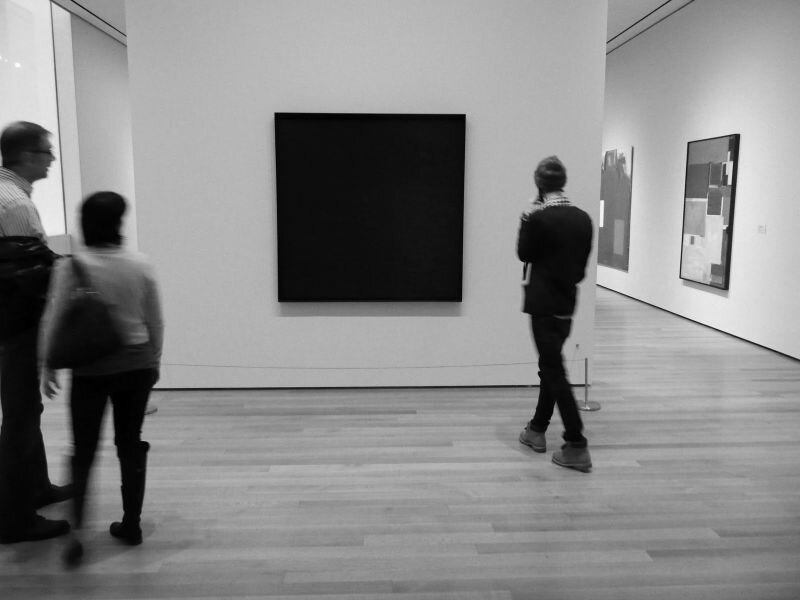What does it really mean? Artistic research
Everyone is suddenly talking about “artistic research” and the “artist as researcher”. Only since recently can artists and designers undertake a PhD at the University, a new Master Artistic Research has started at the Royal Academy of Fine Art of The Hague, and art tutors are conducting research.
Ad Reinhardt (1913 – 1966) said his black paintings were about “nothing”. In the first of these paintings, made in 1953, darker tones of green, red and blue were discernable. They also varied in size. But from the 1960’s until his death, Reinhardt only painted black canvases on identical formats, five by five feet (157,5 x 157,5 centimetre. He was “painting the very last paintings,” he said, “the last that you can make.”
The paintings are severe, although they are less stringent than you might initially think. They are not evenly black, in some places the paint is more matte, catches more light, than in other spots. Glancing sideways at the surface, you’ll see squares within the paint, and Greek crosses. Otherwise, every other characteristic of a painting has been discarded: representation, composition, brush stroke, expression, and colour. Yet, they are not anonymous or mechanical. The black breathes, is space. These paintings are exceptionally fragile, because Reinhardt used minimal amounts of binder to ensure a paint made almost purely of pigment. The black plane is unfathomably deep, and all light disappears into these depths.
Reinhardt owes his important position within modern art to these black canvases, as well as to his radical views on painting. But to the general public, he was known in a very different manner, namely as cartoonist for, among others, the magazine The New Yorker. In 1946, Reinhardt made a series of cartoons named “How to Look at Modern Art”. One of the drawings from this series, “How to Look at a Cubist Painting”, is depicted above.
A mocking viewer responds to a cubist painting. In English, “to represent” has the same double meaning as in Dutch: “to represent” as in “to portray” or “to display”: but also “to represent” in the sense of the degrading, “that doesn’t represent much”, “that doesn’t mean much”. By angrily retorting, “what do YOU represent?” the painting confronts the viewer with himself.
And this is exactly what happens while looking at an artwork. The artwork is silent and confronts you with yourself. As opposed to all other forms of art like theatre, music, dance, and literature; visual art does not immediately immerse you. This silence is not only relevant to painting and sculpture, but in general also to performance, video, film and acoustic art: little is “said”, and there is no finality in intent, or hardly. Duration of time is rarely ever prescribed. The artwork unfolds itself within the span of time that the viewer takes to look at the work. The “narrative” that arises is the exchange between the viewer and the artwork.
Only through the viewer’s effort does the artwork reveal itself. The viewer must take the first step, open himself up, and set aside his own preconceived notions. He can then penetrate the work and engage with the artwork. Within this dialogue, the distance is bridged between one world of thought and another. The experience of engagement with an artwork allows the viewer to become aware of the activity of his own thinking, of living, and of being alive. As the philosopher Hans-Georg Gadamer said: experiencing art is a “multiplication of existence.” This is what makes artworks important.
It’s difficult to look, said Reinhardt, but we can learn to do so through art. This is not just true for the viewer; it also counts for the artist himself. The artwork is the result of the combination of the desire to make something and the desire to see something. The artist is the first viewer of the artwork. He must learn to see what it is that he’s made, and to recognize it’s meaning. This is reflection; thinking about one’s own experiences and about how and why something has been made, with the goal to clarify the structure of the work and to find a foundation and a context for it. This reflection can only take place once the maker distances himself from the experience of making. To then, if the work is unfinished, pick up where he left off.
The artist's reflection on his own work is the subject matter of artistic research. Within this, the importance of the process of making outweighs that of the final product. Artist-researchers share this reflection with others through conversations, debates, publications etcetera; and are likewise fed by this.
making = thinking
thinking = speaking
speaking = thinking
thinking = making


